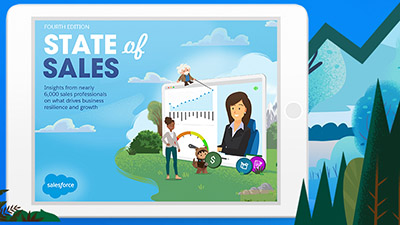How PayPal unifies teams and systems for better customer experiences.
Learn the six ways PayPal uses data to create a 360-degree view of its customers.
Businesses demand fast, flexible, and secure ways to manage online payments. Looking beyond a checkout point solution, they now expect an ecommerce partner that can offer solutions to help them seamlessly run their business from anywhere. PayPal, the world’s leading online payments platform, is on a journey to transform how it delivers those solutions to its 392 million business and consumer account holders.
Over the past several years, PayPal has focused on advancing its product innovation and strategic partnerships to better serve its customers. With its rapid growth and numerous acquisitions came the need to unite several separate CRM systems, teams, and processes. PayPal sought to improve visibility and quality of data across departments so they could win more customers by getting to know their needs and concerns.
Dan Torunian, Vice President, Employee Technology & Experiences, recognized that, to elevate customer experience and grow the company’s customer base, PayPal would have to connect technology and people more effectively.
Let’s take a look at how Dan and his team are using Salesforce Customer 360 to do exactly that, helping them reach their goal of engaging 1 billion customers by uniting teams and company data with a single customer view. We’ve translated their learnings into actionable steps you can take to unite your company around your customers, too.
Table of Contents
1.Unite teams with a single view of the customer to deliver connected customer experiences.
Previously, if PayPal merchants were interested in an additional PayPal product, they had to speak to a different representative for each product. With each new conversation, PayPal team members entered details in separate systems, preventing them from getting a clear picture of the customer’s overall history or product use with the company.
To streamline this experience, PayPal unified sales, service, and customer success teams to work together with a 360-degree view of all the customers’ interactions with the company, so teams can show up as one company, not a patchwork of separate entities. Team members are armed with the right information to recommend a solution, fit for every business need, making it easier to support and engage customers with context and relevance.
“Having a single source of truth allows our employees, to have the knowledge and data [they need] at their fingertips,” said Dan Torunian, Vice President, Employee Technology & Experiences and Data Centers.
2. Scale up sales processes by unifying data on one CRM.
To meet its company growth goals, PayPal needed to better scale its sales operations. operations. As a highly acquisitive company, PayPal Holdings has many sales teams, each with its own system and process. The company needed a better way to plan, forecast, and share data between teams and sell across product categories.
PayPal started by bringing all its sales teams under one umbrella and consolidating its data from four systems into a single sales CRM. Sales reps could leverage automation, scoring, and analytics to make it easier for team members to access information and confidently sell across the company’s entire portfolio.

“One of our biggest priorities is to remove the subjectivity from the sales cycle,” Torunian said.
Key performance indicators (KPIs) were built right in the CRM foundation to remove subjectivity from the sales cycle, enabling sellers to forecast more accurately and align territory and accounts among their teams.
With practical and visual insights embedded into the workflow, team members can more easily understand customers and make better decisions, including what solutions to recommend or sell next.
PayPal also reimagined how its sales teams access relevant information, templatizing sales and service best practices, and important account planning information, into a single collaboration tool. Now, PayPal’s teams can communicate more easily from anywhere, and gain greater visibility over the work being done on an account.
What drives sales growth and productivity during a pandemic? Find out in the State of Sales report.
Fill out the form to get access to insights from 6,000+ sales professionals on how to sell to today’s virtual buyers.
3. Automate the sales cycle to speed up revenue growth.
By leveraging automation, scoring, and analytics across its entire sales cycle, PayPal has freed up time for team members to focus on selling and closing deals faster. Automation shortened sales cycles and simplified quoting processes, allowing the company to realize revenue sooner.
“One of the biggest challenges when we were engaging with customers was to line up all the things we needed to organize internally,” said Frank Keller, PayPal's Senior Vice President, Enterprise Solutions & Digital Commerce. “It often took a long time to get an offer out or adjust it when negotiating with a customer. Now, through automation and greater predictability, we’re able to close deals much quicker than before.”
Having a single view of the customer gives sales team members the information and insights they need to not only act as a trusted advisor but create personalized experiences at every buying touchpoint. It also helps team members to upsell and cross-sell more effectively.
Consolidated technology also gives leadership the tools needed for more accurate forecasting, allowing them to make better business decisions and continually improve sales processes.
4. Become trusted advisors with connected service.
By aligning its sales and services teams more closely, PayPal is able to ensure its employees present as one team to customers across all touchpoints and channels. For example, being able to see details of a customer’s previous interactions with the company enables it to deliver effortless customer experiences.
PayPal is also working to transform its customer service to improve first-call resolution and customer satisfaction scores, while also reducing customer churn. With a single dashboard to review current information, automated tasks, and intelligent guided workflows, service agents have the tools they need to act as trusted advisors, create more meaningful customer interactions and build long-term loyalty.
“Service Cloud will help us significantly improve our ability to meet the customer with empathy at scale,” said Guru Bhat, PayPal’s Vice President, Omni-Channel, and Customer Success Platform. “This efficiency and understanding translates into better customer perceptions of our service and higher scores.”
5. Enhance security by streamlining data integration.
The experience that third parties have with PayPal is as important as the one that customers have. PayPal has made it simpler for third parties and partners to use its products by replacing its legacy integration setup with a modern API infrastructure. Fully compatible with the company’s technology stack, this infrastructure unlocks and allows data from different sources to talk to each other seamlessly and deliver critical projects faster.
“PayPal has so many different systems and capabilities,” said Torunian. “MuleSoft links them together like a railroad or freeway to communicate with each other in a seamless, effective, and secure way.”
6. Prepare for the unexpected with strong foundations.
Having united its business units around customers prior to COVID-19, PayPal had the strong foundations it needed to stay customer-focused when the pandemic hit.
PayPal could better determine which solutions were best for merchants’ rising ecommerce needs — especially those that moved to an ecommerce-first model to continue business.
Sales leaders could quickly redeploy sales reps to serve fitness companies that needed to upgrade their web-based payments experiences, for example, as they began offering virtual classes.
PayPal’s strong digital backbone also enabled the company to continue accelerating when it mattered most, quickly adapting its go-to-market offerings and maintaining predictable revenue.
Ready to put customers at the center of everything you do?
More Resources

Demo
How Salesforce Drives More Revenue Faster

Guide
State of Sales Report

Guide
Your Guide to Customer-Focused Technology






